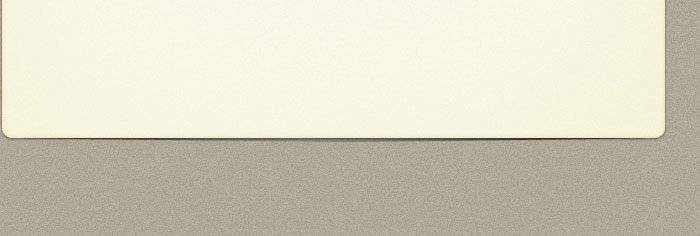

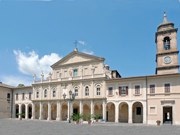
History
St Anastasius and the First Duomo of Terni

9th Century Church
The cemetery mentioned above seems to have remained in use until the 9th century, when another church was built on the site. It is probable that the presumed relics of St Anastasius were discovered during the construction of this new church. According to the legend of St Anastasius, their location remained unknown until the reign of the Emperor Lothar I (817-55), when it was revealed to a farmer from San Gemini; St Anastasius appeared to him in a dream and ordered him to search near the left door of the “domum genetricis Ihesu Christi” (the house of the Mother of Christ). His efforts came to nothing, but a marble funerary urn was found there soon after during a burial service and, when it was opened, an odour of sanctity was detected. Terni formed part of the diocese of Spoleto at this time, so Bishop Liutardus of Spoleto (ca. 829-44) was called to verify the discovery. He ordered an “altare venerandum” to be built on the site of the grave.
The 9th century church had the opposite orientation to that of the original oratory, and its facade split the apse of the oratory from its nave. The altar that Bishop Liutardus commissioned seems to have been on its counter-facade, above the nave of the old oratory, which functioned as a crypt in which the relics were preserved.
This church seems to have been destroyed this building in 1174, when Archbishop Christian of Mainz sacked Terni on the orders of the Emperor Frederick I.
Santa Maria Interamnes (12th century)
A new church was built on the ruins in the 12th century. A community of canons administered it, and the prior, Ranierio became Bishop of Terni when the Pope Honorius III restored the independent diocese in 1218. St Francis preached before Bishop Ranierio outside the Duomo at about this time, and tradition has it that he had interceded with Honorius III to reinstate the diocese.
The Duomo was re-modelled in 1439. Another radical restoration began in 1546, when the Cathedral Chapter decided to extend the nave and to build a new tribune “di recente elegante stile” (in the modern, elegant style). This was certainly prompted by the changes propounded by the Council of Trent that required the canons’ choir to be behind the high altar, allowing the congregation in the nave to watch the Mass. The new choir stalls were installed in 1559.
The rest of the church was restored in the following decades. Bishop Bartolomeo Ferri translated the relics of St Anastasius to a temporary location in 1573 so that chapel on the counter-facade that was dedicated to him could be demolished. During an apostolic visit at this time, Bishop Pietro Camiaino of Arezzo described the Duomo as “ congeries ruinarum videtur plus quam ecclesia” (a heap of ruins rather than a cathedral). The work of retoring it was presumably complete by 1591, when the new Cappella di Sant’ Anastasio was ceded to the Castelli family.
Present Church (1653)
An inscription that is now in the Sacristy (see below) records that Bishop Cardinal Francesco Angelo Rapaccioli rebuilt the Duomo in 1653 and re-consecrated it in honour of Santa Maria Assunta. Gian Lorenzo Bernini may have played some part in the overall design: he certainly designed the organ, which Luca Neri built in 1647, as well as a high altar and an episcopal throne that have since been replaced.
The crypt below the Cappella di Sant’ Anastasio on the counter-facade seems to have survived until 1783, when the pavement of the Duomo was relaid. The relics of St Anastasius were presumably moved at that point: they were translated to their current location, in the crypt under the crossing (see below) in 1905.
Bishop Cesare Boccoleri restored the Duomo in 1933-7 after another earthquake.
Exterior
As noted above, the façade of the present church coincided with that of its 9th and 12th century predecessors.
-
✴Part of the 9th century facade seems to survive in the facade of the present church, above the excavated apse of the oratory. A small diamond shaped window in it seems to have been inserted in order to provide a view of the altar of St Anastasius and perhaps of the reliquary below. (The present window seems to date to the early 15th century, but it probably replaced an older one, and people seem to have come here to secure miracles of healing).
-
✴The main portal of the 12th century church survives in situ. An inscription “Ocellus Scinda Iohs Nachera” probably refers to a sculptor from Narni. (The bronze doors (2000) are by Bruno Ceccobelli).
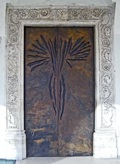
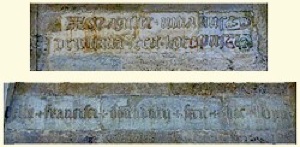
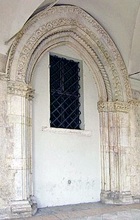
-
✴The two-line inscription illustrated above records that “Magister Julianus de Milna fecit hoc opus” (Master Julian of Milan did this work); and
-
✴the single-lined inscription illustrated below it adds the name “Francisci Donatutii” and the date 1439.
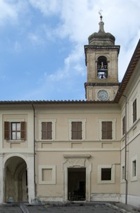

Interior
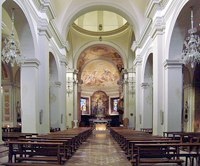
Traces of the bifore windows (12th century) of the earlier church can be seen to the sides of Christ in the fresco (2007) on the counter-facade (see below). Traces of the rose window used to be visible between them, but these were removed when the fresco was painted.
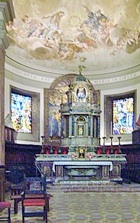
Trinity in Glory (1782)
This fresco in the semi-dome of the apse by Liborio Coccetti has been heavily repainted.
Fresco fragments (15th century)
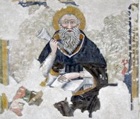

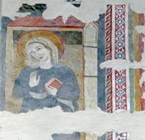
Traces of other broadly contemporary frescoes can be seen just inside the space that is now reached through the glass door of the left wall of the right transept.
Martyrdom of St Catherine of Alexandria (17th century)
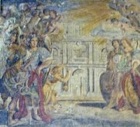
Resurrection of the Dead (2007)
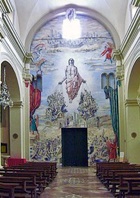
Scenes from the lives of the Virgin and of Jesus (2007)
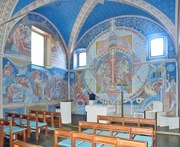
These neo-Byzantine frescoes by the Russian artists Valerij Chernoritskij and Anastasia Sokolova are in the Cappella Maria Madre della Chiesa. This chapel has been established in the “winter choir”, which is reached from a door on the left of the right transept.
Panels in Restoration
Madonna and Child with saints (17th century)
This altarpiece, which came from the Franciscan nunnery of Santa Caterina, is usually on the right wall of the left transept. It depicts the Madonna and Child with St Catherine of Alexandria, to whom the baby Jesus gives a wedding ring, and SS John the Baptist and Francis.
Sacristy
The sacristy, which is reached from a door on the right of the right transept, contains a number of interesting archeological remains.
Relief (6th century)

This marble relief, which depicts two peacocks kneeling before the Lamb of God, may have come from a portal in the first church on the site.
Relief (12th century)

This relief, which depicts birds in vines, is similar to those used in the portal of the present church.
Relief (15th century)
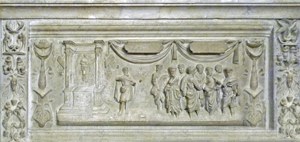
This relief, which depicts the stoning of a Christian saint, is traditionally said to represent instead the revolt of Liberotto Liberotti.
Inscription (1653)

This inscription records the fact that Bishop Cardinal Francesco Angelo Rapaccioli rebuilt the Duomo in 1653 and re-consecrated it in honour of Santa Maria Assunta.
Sarcophagus of Bishop Luigi di Apera (ca. 1520)
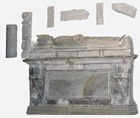
[A crucifix and a figure of the grieving Virgin attributed to Giovanni Tedesco in the sacristy ??]
Crypt (9th century ?)
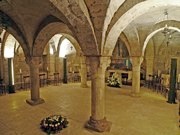
The crypt under the crossing was rediscovered in 1890 and restored by Luigi Lanzi in 1904. It is in the form of a nave and two aisles defined by four ancient columns, and a semi-circular apse. The remains of three windows in the apse suggest that this was originally a church in its own right above ground; it is possible that tis was the apse of the 9th century church. The altar has been adapted from a Roman altar and incorporates a column decorated with a relief of the head of a cow.
While he was restoring the crypt, Luigi Lanzi discovered fragments of a Roman sarcophagus in the garden of Palazzo Vescovile. He believed that the sarcophagus had originally contained the relics of St Anastasius, so he embedded the fragmenrs in the right wall.
The relics of St Anastasius were translated to the niche between the two entrances from the church above in 1905. Two Cosmatesque mosaics (12th century), which probably came from the Cappella di Sant’ Anastasio on the counter-facade, have been inserted to the sides. They have inscribed prayers to St Anastasius, which read:
-
✴“Tua, Sancte Anastasii, interventio ad baratrum ubi nulla est redentio succurrat ne Guido vadat” (on the left); and
-
✴“Celesti regno potiatur Rusticus huius precibus ac meritis Anastasii presulis almi” (on the right).
Treasury
The Treasury contains a 17th century reliquary of St Proculus, a predecessor of St Anastasius.
(The Treasury was closed during my visits in January 2009 and May 2010).
Art from the Duomo
Arms of Bishop Ludovico Mazzancolli (1460)
These arms,which contain a funerary inscription commemorating Bishop Ludovico Mazzancolli (died 1458) came from his tomb in the Duomo. They are now in the Civic Lapidiary Collection.
